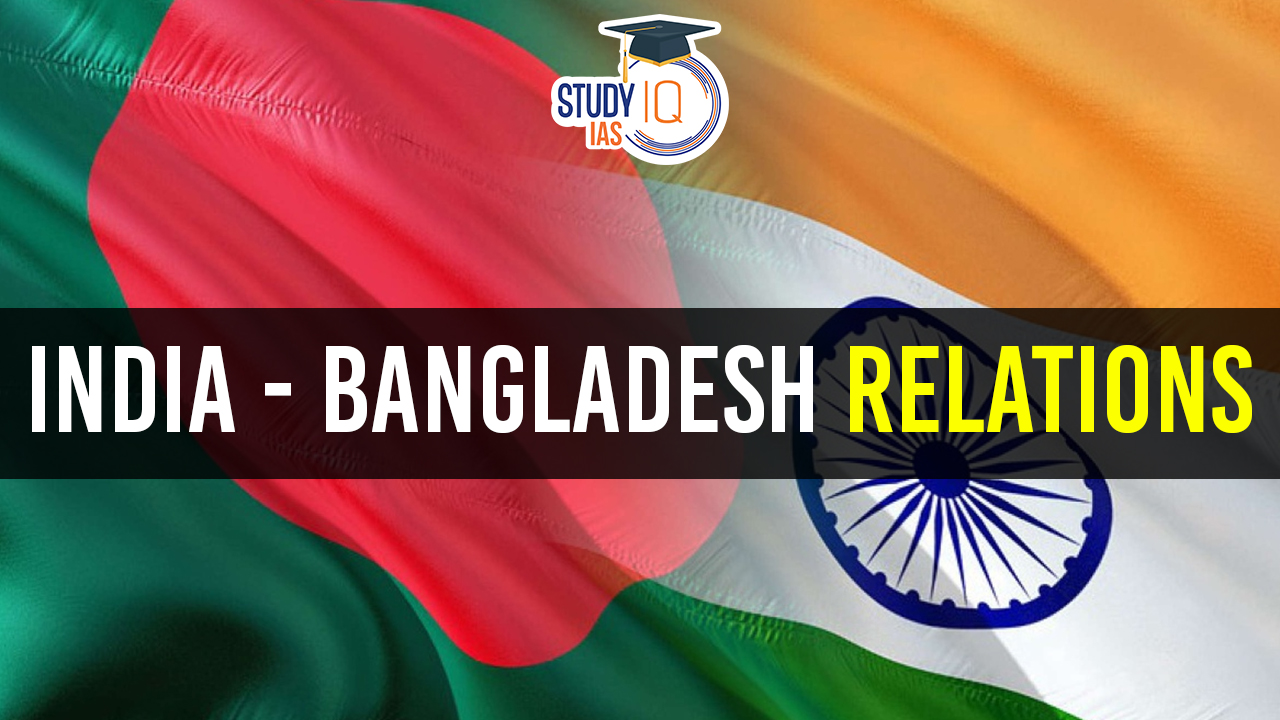Table of Contents
Context: Violence targeting Hindus in Bangladesh (August 2024), have sparked concerns about the safety and status of religious minorities in the country.
About India-Bangladesh Relation
Evolution of Regional Geopolitics
- Over time, the Nehru-Liaquat Pact failed to safeguard even Muslim majority rights in East Pakistan, especially Bengali Muslims.
- This neglect helped fuel the 1971 Bangladesh Liberation War, leading to the creation of Bangladesh.
- The two-nation theory thus ironically resulted in the emergence of three nations: India, Pakistan, and Bangladesh.
Foundation and Early Friction (1971-mid-1970s)
- 1971: India plays a crucial role in supporting Bangladesh’s independence from Pakistan.
- Mid-1970s: Anti-India sentiment rises in Bangladesh due to border disputes, insurgency, and water-sharing issues.
- Military regimes in both countries further strain relations.
Turning Point and New Chapter (1996-present)
- 1996: Sheikh Hasina’s rise to power in Bangladesh marks a turning point.
- Treaty on Ganges water sharing strengthens bilateral ties.
- Since the watershed moment in 1996, India and Bangladesh have progressively strengthened their partnership, focusing on areas such as trade, energy, infrastructure development, connectivity, and defence cooperation.
- 2019: The Prime Minister of India recently referred to the current state of the bilateral relationship as ‘Sonali Adhyay‘ (golden phase).
We’re now on WhatsApp. Click to Join
Areas of Cooperation between India-Bangladesh
Political
- India’s support in terms of humanitarian aid, moral support, diplomatic efforts, and military assistance played a crucial role in the liberation of Bangladesh.
- Sheikh Mujeeb ur Rehman, popularly known as Bang Bandhu, openly recognized that maintaining a friendship with India is a fundamental aspect of Bangladesh’s foreign policy.
Security & Border Management
Coordinated Border Management plan, signed in 2011, which aims to synergize the efforts of both countries’ border guarding forces in effectively controlling cross-border illegal activities and crimes.
- The India-Bangladesh Land Boundary Agreement (LBA) came into effect in June 2015.
- This agreement facilitated the exchange of enclaves between India and Bangladesh and the signing of strip maps.
- It is expected to enhance border management and address issues related to trafficking, illegal movements, and more.
- The settlement of the maritime boundary arbitration between India and Bangladesh, based on the UNCLOS award in 2014, has opened avenues for economic development in the Bay of Bengal region, benefiting both countries.
- India and Bangladesh have established an annual Coordinated Patrol (CORPAT) as a joint initiative between their navies.
River Water Management
India and Bangladesh have a shared responsibility for managing the waters of 54 rivers, with Bangladesh being the lower riparian country.
- Being a lower riparian country, Bangladesh faces potential risks and impacts from the rivers originating in India.
- However, India provides Bangladesh with seasonal water flow and rainfall data to assist in flood forecasting.
- To facilitate effective cooperation and maximise the benefits from the common river systems, a bilateral Joint Rivers Commission (JRC) has been operational since 1972.
- The Ganges Waters Treaty, signed in 1996, has also been successful in facilitating the sharing of water from the River Ganges during the lean season.
Bilateral Trade
Bangladesh has emerged as India’s largest trade partner in South Asia, with bilateral trade reaching $18 billion in 2021-2022.
- India is also the second biggest trade partner of Bangladesh, with exports amounting to $2 billion in Indian markets.
- Both countries are actively working on strengthening economic cooperation, including joint investments and collaboration under the ‘Blue Economy’ program, which focuses on the exploration of hydrocarbons, marine resources, deep-sea fishing, marine ecology preservation, and disaster management among littoral states.
- Bangladesh has received significant duty concessions under agreements like SAFTA, SAPTA, and APTA.
- In 2022, both nations concluded a joint feasibility study on a Comprehensive Economic Partnership Agreement (CEPA).
- The CEPA gains additional significance as Bangladesh is set to lose its Least Developed Country (LDC) status after 2026, thereby losing its duty-free and quota-free market access in India.
- Since 2011, India has provided duty-free, quota-free access to Bangladesh (and other SAARC LDCs) on all tariff lines, except for sensitive items such as tobacco and alcohol, under SAFTA.
- Additionally, four Border Haats, two each in Tripura and Meghalaya, have been established to benefit communities along the border.
- Investments and Indian Foreign Direct Investment (FDI) in Bangladesh have shown significant progress.
- India is funding several infrastructure and connectivity projects. Since 2010, India has extended Lines of Credits worth over $7 billion.
Energy Sector Cooperation
- Power transmission between the two countries takes place through interconnections like the Berhampur-Bheramara interconnection and Suraj Mani Nagar-Comilla interconnection.
- India, Russia, and Bangladesh signed an agreement to construct the Rooppur atomic plant in Bangladesh.
- The Maitree thermal power plant, with a capacity of 1320 MW, is a joint venture between the National Thermal Power Corporation (NTPC) of India and the Bangladesh Power Development Board (BPDB).
- It is a coal-fired power plant being developed in Rampal.
- Several Indian public sector units, including the Indian Oil Corporation, Numaligarh Refinery Limited, Gas Authority of India Limited, and Petronet LNG Ltd, are collaborating with their Bangladeshi counterparts in the oil and gas sector of Bangladesh.
- In 2018, the construction of the India-Bangladesh Friendship Pipeline Project was inaugurated.
- This pipeline, spanning 130 km, connects Siliguri in West Bengal, India, to Parbatipur in the Dinajpur district of Bangladesh.
Connectivity
- For road transport, there are 36 functional Land Customs Stations (LCSs) and 2 Integrated Check Posts (ICPs) along the border, enabling the operationalization of goods transportation.
- Since 1972, the Protocol on Inland Water Trade and Transit (PIWTT) has facilitated the movement of goods through barges/vessels on eight specific routes across the river systems of Bangladesh.
- Connectivity through Coastal Waterways, facilitated by the Coastal Shipping Agreement, has enabled direct sea movement of containerized, bulk, and dry cargo between the two countries.
- The passenger train service ‘Maitree Express’ between Kolkata and Dhaka now operates four days a week and has been converted into a fully air-conditioned (AC) train service.
- The Bangladesh, Bhutan, India, and Nepal (BBIN) Motor Vehicles Agreement (MVA) aims to enhance road connectivity.
- Akhaura-Agartala rail link: It connects Bangladesh and the northeast through Tripura. The link has given India access to Chattogram and Mongla ports in Bangladesh for the movement of cargo. It is likely to boost small-scale industries and develop Assam and Tripura.
Cultural Exchange
- The High Commission of India has been publishing the Bengali literary monthly magazine ‘Bharat Bichitra’ in both print and electronic editions for the past 43 years.
- This magazine is highly regarded in Bangladesh and enjoys a large readership across different sections of society.
- The Indira Gandhi Cultural Centre conducts regular training courses in various disciplines such as Yoga, Hindi language, Hindustani Classical Music, Manipuri Dance, Kathak, and Painting. These courses are well-received by Bangladeshi students and have gained popularity.
Challenges in India-Bangladesh Ties
Current Challenges
- Despite India’s crucial role in liberating Bangladesh, relations are no longer based on gratitude.
- The status of Hindus in Bangladesh has become a contentious issue in bilateral relations.
- Key debates include:
- Whether violence is politically motivated or represents a systematic targeting of Hindus.
- Critics argue India’s foreign policy has become overly personalized around Sheikh Hasina’s family, neglecting broader democratic engagement.
- There is no ideological consensus within Bangladeshi society on secularism, making minority safety precarious.
- Teesta Water Issue: The sharing of Teesta River waters has been a contentious issue between the two countries. Bangladesh seeks an equitable distribution of water, while West Bengal’s concerns about the impact on its own water supply have hindered the signing of a treaty.
- China’s Influence: India is concerned about China’s increasing influence in Bangladesh, particularly through infrastructure projects such as the development of ports. India views Bangladesh’s proximity to China’s “One Belt, One Road” initiative as a potential threat to its own regional influence.
- Bangladesh is keen on concluding a Free Trade Agreement (FTA) with India, while simultaneously showing interest in the China-supported Regional Comprehensive Economic Partnership (RCEP). This two-pronged strategy presents potential challenges for India.
- Illegal Migration and Insurgency: The porous border between the two countries has led to a significant influx of illegal migrants, posing socio-economic and security challenges for India. The presence of insurgent groups, such as the Jamaat-ul-Mujahideen Bangladesh (JMB), also raises concerns about terrorism.
- Rohingya Crisis: India’s handling of the Rohingya refugee crisis has been a point of contention. Bangladesh expected India to play a more proactive role in resolving the crisis, but India’s approach and stance have been disappointing to Bangladesh.
- Drug Smuggling and Trafficking: Cross-border drug smuggling and human trafficking are significant challenges that require joint efforts to combat. The illegal trade poses risks to both countries’ security and social fabric.
- Border Disputes: Unresolved border issues, such as the non-demarcation of a land border along Comilla-Tripura, continue to strain the bilateral relationship. Concerns over the impact on local communities have hindered progress in resolving these disputes.
- Public Discontentment: There are various issues that have led to public discontentment in Bangladesh, including market access for Indian energy companies, border restrictions, unresolved agreements like the Teesta treaty, and limited market access for Bangladeshi companies and TV channels.
Way Forward
- Teesta River Water Sharing: Efforts are required to reach a mutually agreed upon decision on the allocation of Teesta river waters, aiming to finalise the agreement within a set timeframe.
- Enhanced Regional Connectivity: Improving regional connectivity is crucial, focusing on bolstering cooperation in coastal links, road and rail networks, and inland waterways.
- Joint Efforts in Energy Security: In light of the escalating global energy crisis, it’s essential for India and Bangladesh to collaborate in harnessing clean and renewable energy sources to achieve energy self-sufficiency in South Asia.
- Accelerating the India-Bangladesh Friendship Pipeline Project: The completion of the pipeline that facilitates the transfer of high-speed diesel from India to Northern Bangladesh should be expedited.
- Balancing China’s Regional Influence: By providing Bangladesh with critical technologies and financial support, India can strengthen its ties with Bangladesh and effectively balance China’s growing influence in the region.
- Addressing the Refugee Crisis: India and Bangladesh should lead efforts within the South Asian Association for Regional Cooperation (SAARC) to create a SAARC declaration on refugees. This declaration should outline clear procedures for identifying refugee statuses and differentiating economic migrants.


 America’s Plan to Manage AI Proliferat...
America’s Plan to Manage AI Proliferat...
 Turning Point in Eurasia and its Implica...
Turning Point in Eurasia and its Implica...
 South Asian Economic Integration: Potent...
South Asian Economic Integration: Potent...





















